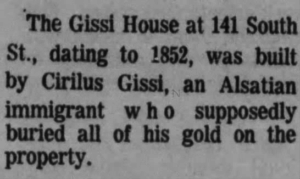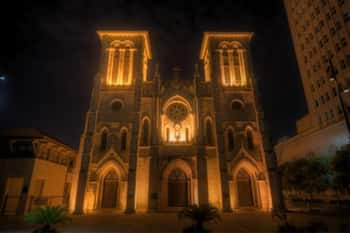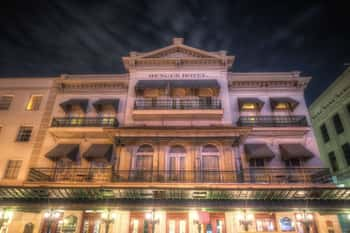
San Antonio's La Villita (The Little Village), is the city's oldest neighborhood, around even before the Alamo, this plot of land at one time was a Native American settlement. Over the years, La Villita has had the highest of highest and the lowest of the lows. For a time the neighborhood was considered a slum, but in recent years the historic La Villita has turned a corner, it has established itself as a thriving art community and the future once again looks bright for this neighborhood.
Downtown, San Antonio is lined with historic stores, buildings and hotels, many of which are haunted. La Villita, is one area of downtown, that is consider to be a hotbed of paranormal activity. So, it's safe to say La Villita (The Little Village) is a great spot for those who are seekers of all things supernatural. Some of the strange happenings to occur in La villita come in the forms of objects spontaneously moving around, phantom arguments, drops in temperature and shadowy figures.
Some have reported seeing a the spirit of women in an apron, while others have encountered a "Woman in White." But, possibly the most creepy of all, is the legend of a ghostly little girl, who is said to have taken up residence at La Villita House. La Villita is definitely a nighttime haunting location, so if you happened to find yourself in the neighborhood during the after hours, don't be surprised if you come across one of these spirits in the shadows.
If you ever travel near the San Antonio River, visit the south bank, there you'll find La Villita, the first neighborhood in San Antonio. Originally, home to Native Americans, it was later settled by Spanish soldiers who had been stationed at the Mission San Antonio Valero, or as it is better known, the Alamo. La Villita was initially more on the primitive side, with a clustering of jacales (thatch-roofed wattle and daub huts), but it quickly became more than just a collection of huts for the soldiers and their families. It soon became a community.
In the year of 1819, the puddles gathered rain in a big way, with a flood destroying all of the Jacales. But, the neighborhood came back strong, and improvements were made to La Villita, with new adobe houses. Nearly two decades later (in 1836), La Villita was used by General Santa Ana for his cannon line during the Battle of the Alamo.
Towards the end of the nineteenth century, German and French immigrants began moving into the neighborhood. This movement helped in the modernizing of San Antonio, with new business leaders, bankers and teachers. La Villita was also further developed, with an array of different architecturally designed building and larger houses. These new structures quickly began popping up all around the community.
However, in the twentieth-century, La Villita began to deteriorate, even before the woes of The Great Depression. The once bold and vibrant neighborhood had been reduced to a skid row, a slum. A place of neglect, and a breeding ground for misspent time.
During the 1930s, La Villita was considered to be the worst of all the slums in San Antonio, which is saying something, as the city had a number of infamous skid rows. But, civic leaders were determined to revive the historic neighborhood.
In the year of 1939, the Mayor of San Antonio, Maury Maverick (the grandson of Samuel Maverick, one of the signers of the Texas Declaration of Independence) partnered with the National Youth Administration.
They were able to find jobs for 300 young men, and find new housing for 119 people who were living in deplorable conditions. In one case they found 26 people crammed in two rooms. Throughout the houses on the block, they found the insides filled with vermin, rats and disease. There was also only two bathtubs and three outdoor toilets for the 119 people living on the block. So, sleeves were rolled up, and boots were pulled up by their straps, and 162 truckloads of removed junk later, people were able to walk around without having to pinch their noses shut.
Mayor Maverick also authored the La Villita ordinance (adopted by the City Council on October 12, 1939). In the ordinance he state, "La Villita shall not and must not be a restoration and reconstruction of the dead past, and a ghost village for the mincing walk and dusty ways of scholars, but likewise for the average living citizen. Even a jitterbug has the same constitutional right of life and liberty as the scholar who is crammed with knowledge and will not disgorge it. Moreover, there are more jitterbugs than scholars."
Maverick proud of his work in revitalizing San Antonio's first neighborhood, would joyfully boast to visitors like Eleanor Roosevelt and H.G. Wells about La Villita, he then would show them around the neighborhood. Of all the titles Maury Maverick held in his long career in San Antonio politics, he only ever referred to himself as the "Mayor of La Villita." Obviously Maury, like his grandfather was a maverick, and yes, Samuel Maverick is the source of the term (maverick) meaning to be independently minded.
Today, La Villita is known as an arts community, with galleries and shops throughout the neighborhood, which showcases a variety of unique creations. La Villita, also plays host to the annual event, A Night in Old San Antonio, by the San Antonio Conservation Society, which raises proceeds for the preservation of the city's historic properties.
Starving Artist Art Show, is an event that allows young artists the opportunity to show their work, with a portion of all proceeds going to help the elderly, widows and widowers, and the poor. This has been a tradition in La Villita since 1963, and was first organized by Reverend Paul Soupiset. Soupiset was a modern day saint, working everyday to raise funds for the city's most needy. His constant endeavors, earned him the tongue-in-cheek nickname "The Beggar of La Villita."
In the year of 1956 Reverend Paul Soupiset, reached an agreement with the city to lease the Little Church of La Villita, to start a non-denominational ministry for the needy (still in operation today) where service is held twice a week. But, the main purpose of the Little Church, is to feed the neighborhood's poor, lost and hungry.
The good reverend, Paul Soupiset, used to walk the streets of downtown San Antonio with a tin cup in his hand, appealing to the city's kind for help in his noble mission. During the holiday season, Reverend Soupiset, would hit the streets especially hard, in preparation to feed La Villita's needy a proper Christmas Dinner.
The haunted history of San Antonio is well documented, and perhaps no spot in richer in ghostly goodness than the downtown area. You don't even need to go ghost hunting to have an encounter, they'll find you. Besides, in a city as soaked with the blood of the dead as San Antonio, why would you so willingly adventure in seeking one of these possibly vengeful spirits out. Nonetheless, people go to the downtown area often in hopes of having a ghostly experience (although some might just be going to the theater for a late night showing of Ghost).
Some of the most popular sites for paranormal activity are the Spanish Mansion, the Alamo, Menger Hotel and La Villita (The Little Village). These also, just happen to be some of the oldest locations in San Antonio as well. And, where you have historic buildings, you'll most likely have ghosts. All things considered, La Villita might just be the most haunted neighborhood in San Antonio, if not Texas.
The Chamade Jewelry Store (on Villita Street, in La Villita) has reportedly seen its fair share of strange happenings. Inside the store, objects have been known to move seemingly at the own will, disembodied voices have been heard engaging in arguments and cold spots have been felt throughout the store. Some have also claimed to have encountered a ghostly woman wearing an apron. Perhaps the store at one time was a bakery, or better yet, a candy store (who can make a sunrise, sprinkle it with dew, cover it in chocolate and a miracle or two).
Another store in La Villita, where encounters have occurred, is the River Art Gallery (also on Villita Street). This particular ghost is believed to be a "Woman in White," there is no information known about her, and no rumors to who she may have been while alive. This is frequently the case with a "Woman in White," this type of ghost is usually the most mysterious of all the lost souls.
The Starving Artist’s Gallery (another one on Villita, watch out if you find yourself on this street once the sun has fallen), like the Chamade Jewelry Store and the River Art Gallery, the Starving artist gallery has bore witness to unexplained shadows, objects freely moving around and is also haunted by a
spirit of a woman. It is said that this ghost dresses in nineteenth century garb, only appearing once in awhile.
Could there still be gold under the house? (source: San Antonio Express).
La Villita house, also known as the Gissi House, as it was built (in the 1850s) by Cirilus Gissi, is believed to be the home of paranormal forces. It was also rumored that Gissi (an Alsatian immigrant) buried gold on his property after a business venture gone wrong. No gold was ever found in the house, just a few old coins. But, one thing you actually might find if you enter the house, is the ghost of an enthusiastic little girl. Some believe this little girl, was the granddaughter of Gissi.
One of the more spooky, if not downright scary legends, is that the spirits of beheaded Comanche Indians, will on occasion appear out from the night wielding tomahawks, in search for a new head. Surely, this particular tale, is the stuff of campfire legend, meant to scare children and keep them from sneaking out into the dead night.
These ghosts stories shouldn't surprise anyone considering the city's history. It's been said, at the banks of the San Antonio River, just south of the Downtown area, is the location of where the wraiths of murderers were hung for their sins. People claim that on some nights, you can still hear the screams and moaning sounds so clearly, that you would swear someone had just been strung up one of the ominous looking pecan trees.
Famous Sports Writers, Grantland Rice, wrote in regard to the ghosts of downtown San Antonio: "There's the tramp of a ghost on the low winds tonight. An echo that drifts like a dream in it's way; there's the blur of the specter that leaves for the flight, grave-risen at last from a long vanished day; There's the shout and the call of grim soul unto soul of death's shadowed glen. To follow the bugle--the drum's muffled roll, where the ghosts gather again."
Former Archbishop Robert E. Lucey, spoke of renovations made in San Antonio, "We've done such a good job restoring some of the Missions that the ghost probably aren't sure if they are in the same old place."
The Archbishop then went on to explain how there is a formal service of exorcism in the Priest's Ritual Book, but says he had only used it a dozen or so times, and that he certainly would not ever use it on any of the prominent and historic ghosts in the city.
The former Monsignor of Saint Mary Magdalene Catholic Church, Henry S. Herbst said of the paranormal activity downtown, "There are still the occasional believers among the Irish priests in San Antonio." Monsignor even told of a story, about a spirit that prowled between his bedroom and the bulletin board in the Church's rectory late one night.
La Villita Historic Arts Village of San Antonio is quite the attraction with it's blend of new and old, new establishments (like galleries, gift shops and jewelry stores) combined with historically important buildings (some dating back to territorial times).
La Villita, is now managed by the City of San Antonio's Department for Culture and Creative Development. And, the community is once again bold and vibrant, filled with galleries, souvenirs and gift shops, custom jewelry and pottery stores, as well as, some of the best restaurants in the city. La Villita's beauty is only further enhanced by its connection to the San Antonio River Walk and is conveniently just a short walk from most of the hotels downtown.
But, while La Villita's beauty is true, you should still be wary when walking around the neighborhood at night, as you never know when you might encounter one of the ghosts of La Villita.

San Antonio's most haunted Church

San Antonio's most haunted Hotel

San Antonio's most famous haunted landmark